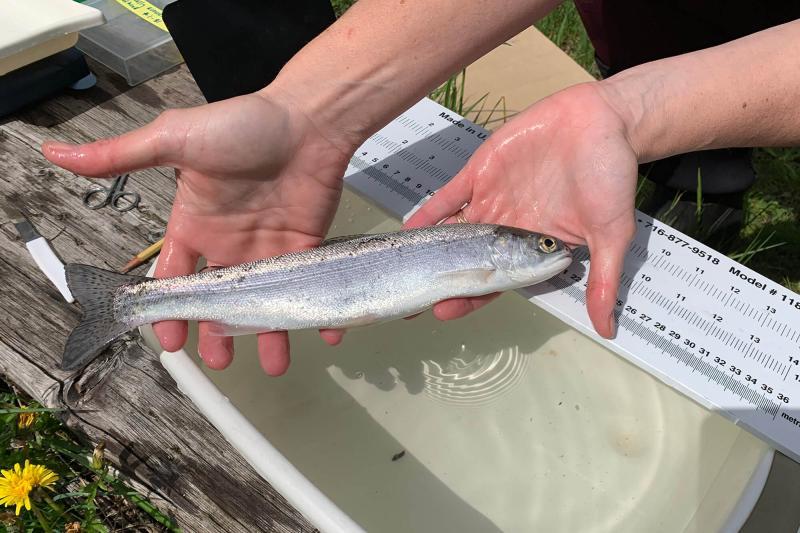
Harbor Seals consume up to a third of Steelhead migrating out of Nisqually River Delta
by NOAA Fisheries 21 Sep 2024 22:26 UTC

Researchers prepare to implant a tracking tag in a steelhead smolt from the Nisqually River to study predation by harbor seals. Researchers found that seals may consume as many as a third of the steelhead © Megan Moore / NOAA Fisheries
Unchecked predation may undermine recovery actions, study finds.
Harbor seals consume as many as a third of young steelhead smolts migrating out of the Nisqually River's delta in southern Puget Sound, new research shows. The finding indicates that recovering populations of predators can derail salmon and steelhead recovery, especially when fish populations are small and struggling.
Scientists said the results, published in Marine Ecology Progress Series, demonstrate the need to test new management actions to exclude seals from areas where salmon are most vulnerable. Although seals are protected by the Marine Mammal Protection Act, some steps may help limit their impacts.
"If we can identify areas with outsized predator impacts on salmon such as river deltas, managers can use that information to focus management actions where they can make the most difference," said Megan Moore, a research scientist at the NOAA Fisheries Northwest Fisheries Science Center, and lead author of the new research.
Two Methods Gauge Predation
The researchers used two different models to estimate harbor seal predation on threatened steelhead smolts. One involved tagging and tracking fish, and the other analyzed harbor seal scat to determine their diet. While the two approaches measured predation over different stretches of the steelhead migration, their findings generally aligned.
The tagging method estimated that seals consumed 11-25 percent of steelhead in their roughly 5-kilometer transit of the Nisqually River Delta, depending on the year. The diet analysis estimated that seals ate 9 to 33 percent of steelhead smolts each year along the 23 kilometers of the Nisqually Delta and areas in South Puget Sound.
Eroding Tribal Fisheries
Steelhead from the Nisqually River at the distant south end of Puget Sound have the longest trip to the ocean at about 275 kilometers. They probably face substantial additional predator impacts the rest of the way. The research adds to a growing number of studies showing that predation by harbor seals is a substantial source of mortality for many Puget Sound salmon and steelhead.
The Southern Puget Sound stock of harbor seals has grown from a few hundred animals to about 2,500 seals last year, according to a recent assessment. The population is still growing.
The 1974 Boldt Decision recognized that the tribes reserved half of the harvestable salmon and steelhead from Puget Sound in the treaties of 1854 and 1855. However, "The Nisqually Indian Tribe has not harvested steelhead from the Nisqually River for more than 30 years," said David Troutt, Natural Resources Director for the Tribe. He said the tribe now catches far fewer fish than before the Boldt decision because so many of the steelhead smolts fall prey to seals as they leave the river.
He said the new research demonstrates that predation by seals is eroding the Tribe's rights to fish guaranteed by treaties with the U.S. government. He said that the results document the urgent need "to use science to manage and reduce predation on our steelhead before they go the way of the bison."
Losses Undo Steelhead Recovery Efforts
The loss of so many smolts over such small portions of the steelhead lifecycle can negate the effects of recovery efforts. The seals remove fish that could otherwise add to the small population already struggling with other threats, such as habitat loss and variable ocean conditions. Other studies have found substantial predation on Chinook salmon, with up to half of young Chinook from Puget Sound lost to seal predation.
The seal diet analysis found that Nisqually steelhead comprised less than 2 percent of the diet of harbor seals in South Puget Sound. The harbor seals in South Puget Sound are so numerous—there are approximately 1,600—that the toll adds up quickly. Some of the smolts may have been lost to other causes anyway. But, the researchers concluded that "it is possible and perhaps likely that predation by harbor seals upon marine entry is substantial enough to represent an additive source of mortality that ultimately reduces population productivity."
Harbor seals' protected status limits management options. However, the research findings support the need to test seal exclusion from the areas where they take the biggest toll, the scientists said. They concluded that excluding seals from key areas would be more practical than trying to manage their impacts along the entire steelhead migration corridor. While special legislation authorized the removal of sea lions preying on imperiled salmon near Bonneville Dam, that authority does not extend to seals in Puget Sound.